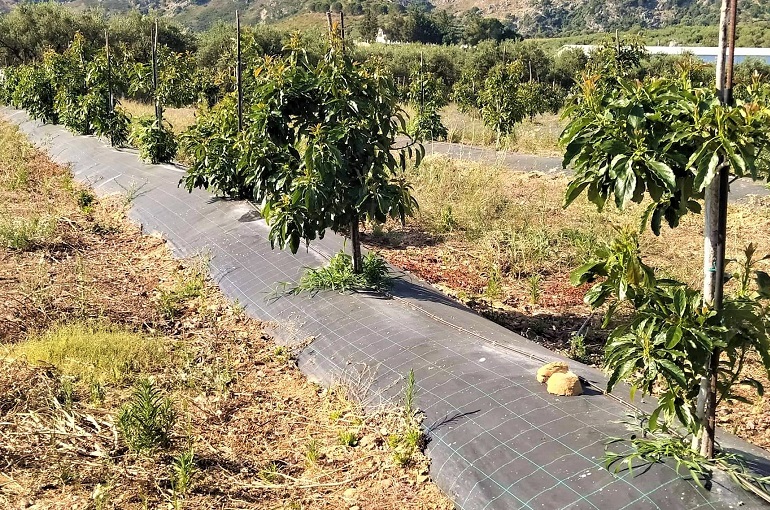Avocado Tree Climate and Soil Requirements – Planting Avocado Trees

This post is also available in:
This post is also available in:
![]() Español (Spanish)
Español (Spanish) ![]() Français (French)
Français (French) ![]() Deutsch (German)
Deutsch (German) ![]() हिन्दी (Hindi)
हिन्दी (Hindi) ![]() العربية (Arabic)
العربية (Arabic) ![]() Türkçe (Turkish)
Türkçe (Turkish) ![]() 简体中文 (Chinese (Simplified))
简体中文 (Chinese (Simplified)) ![]() Ελληνικά (Greek)
Ελληνικά (Greek) ![]() Português (Portuguese (Brazil))
Português (Portuguese (Brazil))
Avocado Tree Climate and Soil Requirements
My orchards (3 hectares) are located in different fields in the Chania region of Crete. The ample sunlight, the warm climate, and the amount of winter rainfalls compose an ideal microclimate for avocado cultivation and the production of high yields. All three varieties that I have planted (Hass, Zutano, and Fuerte) seem to be perfectly adapted to the local conditions.
Soil and location
Avocado trees can grow well in a wide range of soils. The ideal soil for most varieties is loose, loamy, or sandy with a slightly acidic to neutral pH, between 5 and 7 (1). However, farmers should generally avoid establishing an avocado orchard in fields with poor drainage and high salinity. West Indian varieties are generally the most salt-tolerant and are preferred for plantations in coastal regions. The cultivation is possible at elevations from sea level to 2,400m (7,874 ft). Additionally, avocados should be planted in fields with a maximum slope of 15% and areas protected from strong winds. Avocados have a high water demand, and if the rainfalls are not sufficient (annual precipitation of 800–1700 mm) or well spread during the season, there might be a need for irrigation to support high yields (2).
Temperature and sunlight
The sudden temperature changes can stress the avocado tree. Frost is usually not an issue in our region, but the low temperature is one of the most limiting factors for growing this tropical species in other areas. As a tropical crop, avocado can survive temperatures between -4oC and 40oC. However, the level of the damage depends on the duration of these extreme temperatures and the variety. For example, Hass, like most varieties, thrives in an average temperature of 16 – 21 oC (60-70 oF). While young trees (up to 3-5 years) are generally sensitive to low temperatures, mature trees can withstand temperatures as low as -2 oC (28 oF). In order to produce flowers, avocado needs at least four weeks during autumn-winter with cool temperatures. However, during blooming, the temperature should remain above 10oC.
On the other hand, high temperatures can also harm the trees and their production. Temperatures over 40oC can cause severe damage to sensitive young trees and stress the older ones. Most severe problems are recorded during the end of summer when heat waves and warm winds are most common. During this period, avocado trees are in the most sensitive phase since they bloom or form fruits. Such conditions can lead to flower necrosis, fruit drop, and as a result, a significant yield loss. Unfortunately, I have personally witnessed such issues, and the continuous increase in temperature due to climate change worries all the avocado producers in the region. To help our plants during these events, we irrigate and apply Zinc Chelate and zeolite products during flowering. In other areas, farmers use overhead sprinklers for evaporative cooling to preserve the crop (3).
Finally, most avocado varieties need 6-8 hours of ample sunlight daily. The sun will help maintain the bright green color of the leaves and the fruits. In mature trees, sunburns are not very common. However, young avocado trees must be protected. For this, reason many farmers use shading net to protect the young avocado trees from sunburns (7). Intercropping with larger trees, painting the trunks, and using shading nets can help.
Keep in mind that the environmental requirements significantly differ among the avocado varieties. A farmer should examine his/her field, list the limiting factors and select the most adaptive avocado variety.
Planting an avocado orchard – Number of Avocado trees per hectare
After a farmer has selected and purchased the seedlings of an appropriate avocado variety and the field location, the establishment of the orchard is quite simple. Start by clearing the field of weeds since strong competition with the young avocados for nutrients and water may negatively affect their growth. It is generally recommended in colder areas to plant the young trees at the start of fall, while in warmer regions, the mid-end of spring is the most suitable period. This way, the plants will have time to establish and adjust before the extreme temperatures.
Avocado plant distances may vary between 6 to 12 meters depending on the desirable plant density we want to have and the variety we have selected. For example, a wider spacing should be given for varieties with a spreading type of growth, like Fuerte. The most common planting distances are 7 X 7m (23 X 23 ft.), 10 X 5m (33 X 16,5 ft.) , or 6 X 3m (20 X 10 ft.). That will result in a plant density per hectare of 200 trees, or more than 500 trees, respectively (3). In our fields, I selected to plant at a 6 X 6 m scheme (20 X 20 ft.). Ideally, I would prefer 3 X 6m or 3 X 5m distances, but when I planted the trees, there were also orange trees in the field.
It is quite a common strategy to incorporate some manure or compost in the soil before planting in order to offer the necessary nutrients to the young seedling during the first year. The avocado tree is transplanted with the soil ball. The planting hole should be approximately three times wider than the plant container and two times deeper (around 0.6-1m or 2-3 ft). Attention is needed because the roots are sensitive (especially in Hass).
During the first years, the orange trees protected the young avocado from the strong winds and intense sunlight. However, 3 to 4 years later, I decided to remove the orange trees as the avocado plants became bigger. Intercropping or mixed cropping systems with avocado are quite popular in many regions globally. The most commonly used tree -“partners” are orange or citrus trees, coffee trees or even olive trees (4, 1). Alternatively, the farmer can plant annual crops like potatoes, beans, peas, kale, or cabbage during the first 3-5 years between the tree rows to gain some profit until the avocado trees start producing fruits (5).
Attention: Keep in mind that you need to include a “pollinator” variety (of the opposite type, A or B) in a proportion of 1:1, 1:2, or 1:5.
References
- https://www.fao.org/3/X6902E/x6902ehtm
- https://link.springer.com/content/pdf/10.1007%2F978-3-319-06904-3.pdf
- https://www.daf.qld.gov.au/business–priorities/agriculture/plants/fruit–vegetable/fruit–vegetable–crops/avocado/planting–and–growing–avocados
- http://livingagro.maich.gr/
- https://www.kalro.org/sites/default/files/avocado–production–cultivation.pdf
History, Nutritional Value and Plant Information of Avocado
All Avocado Varieties Explained- Characteristics and Advantages
Avocado Tree Climate and Soil Requirements – Planting Avocado Trees
Avocado Tree Propagation and Pollination
Avocado Tree Water Requirements and Irrigation Systems
Avocado Fertilizer Requirements
Training and Pruning of Avocado Tree
Avocado Harvest, Yield per hectare and Storage









































































